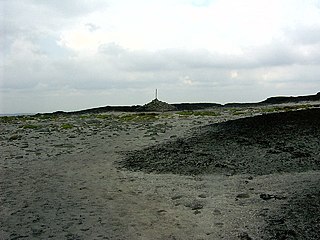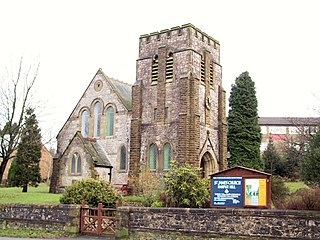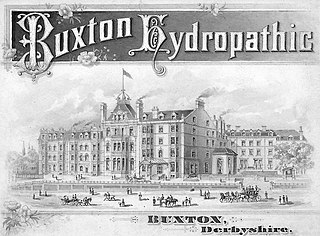
Buxton is a spa town in the Borough of High Peak, Derbyshire, in the East Midlands region of England. It is England's highest market town, sited at some 1,000 feet (300 m) above sea level. It lies close to Cheshire to the west and Staffordshire to the south, on the edge of the Peak District National Park. In 1974, the municipal borough merged with other nearby boroughs, including Glossop, to form the local government district and borough of High Peak.

Royal Air Force Lakenheath or RAF Lakenheath is a Royal Air Force station near the village of Lakenheath in Suffolk, England, UK, 4.7 miles (7.6 km) north-east of Mildenhall and 8.3 miles (13.4 km) west of Thetford. The installation's perimeter borders Brandon.

The Cromford and High Peak Railway (C&HPR) was a standard-gauge line between the Cromford Canal wharf at High Peak Junction and the Peak Forest Canal at Whaley Bridge. The railway, which was completed in 1831, was built to carry minerals and goods through the hilly rural terrain of the Peak District within Derbyshire, England. The route was marked by a number of roped worked inclines. Due to falling traffic, the entire railway was closed by 1967.

Bleaklow is a high, largely peat-covered, gritstone moorland in the Derbyshire High Peak near the town of Glossop. It is north of Kinder Scout, across the Snake Pass (A57), and south of the A628 Woodhead Pass. Much of it is nearly 2,000 feet (610 m) above sea level and the shallow bowl of Swains Greave on its eastern side is the source of the River Derwent.
ROF Glascoed was built as a UK government-owned, Royal Ordnance Factory (ROF). It was designed as one of 20 munitions filling factories. It was planned as a permanent ROF with the intention that, unlike some other similar facilities, it would remain open for production after the end of World War II. After privatisation of the Royal Ordnance Factories in the 1980s it became part of Royal Ordnance plc and later a production unit of BAE Systems.

Royal Air Force Welford or more simply RAF Welford is an active Royal Air Force station in Berkshire, England. The station is located approximately 6 miles (10 km) northwest of Newbury; about 50 miles (80 km) west of London

Harpur Hill is a small village on the outskirts of Buxton, Derbyshire, England. It is in the Cote Heath ward of the High Peak Borough Council. It has a primary school, a park, a pub, a working men's club and a Methodist church.
The logistics organisations of the Royal Air Force in World War II were No. 42 Group RAF and RAF Maintenance Command.
Operation Sandcastle was a United Kingdom non-combat military operation conducted between 1955–1956. Its purpose was to dispose of chemical weapons by dumping them in the sea.
Royal Air Force Ashbourne, or more simply RAF Ashbourne, is a former Royal Air Force station located approximately 1.5 miles (2.4 km) south-east of the town of Ashbourne, Derbyshire, England.
Buxton & Leek College is a college of Further and Higher Education operating at their campuses and facilities in Buxton, Derbyshire, Leek, Staffordshire and Derby, Derbyshire. The college is part of the University of Derby.

Harpur Hill Quarry is a disused limestone quarry on Harpur Hill, Derbyshire, England. Limestone was extracted there from 1835 to 1952 for lime burning at lime kilns to produce quicklime. The quarry was used by the Royal Air Force as a chemical weapons storage depot during the Second World War, the largest such depot in the United Kingdom. Afterwards a number of captured German chemical munitions were disposed of at the site by burning, which was only partially successful. The RAF depot closed in 1960 and the site is now vacant.

Sywell Aviation Museum is based at Sywell Aerodrome in Northamptonshire, England. It is sited in the aircraft viewing car park at the aerodrome. It documents the history of flying in Northamptonshire from the early days to the present day with particular emphasis on the Second World War. The museum is run by the Sywell Aviation Museum Trust and is run by volunteers; it is closed during the winter months and reopens each Easter Saturday.

RAF Bowes Moor was a chemical warfare agent (CWA) storage site run by the Royal Air Force during and after the Second World War. The site was to the north of the village of Bowes in what is now County Durham, England. The Bowes Moor geographical feature runs from the north to the south west of the village. The Royal Air Force used the site to stock its chemical weapon supply, most of which was disposed of in situ by burning. The site, which closed in 1947, is known for the dangerous chemicals which leached into the soil.

This is a partial list of prominent buildings in Buxton, Derbyshire which have been demolished or ruined.

The Bleaklow Bomber was a US Air Force (USAF) Boeing RB-29A Superfortress that crashed near Higher Shelf Stones on Bleaklow in the Peak District in 1948. It was modified as a reconnaissance aircraft, rather than a bomber.

The Peak District Mountain Rescue Organisation (PDMRO) is a UK registered charity which was formed in 1964. The purpose of PDMRO is "to save life and alleviate distress, primarily in Upland and Mountain areas". This is achieved by conducting search and rescue missions for walkers, climbers and missing persons in and around the Peak District National Park.

The Buxton Mountain Rescue Team is a UK registered charity operating search and rescue missions from its base at Dove Holes near Buxton in Derbyshire. The team covers an area of about 400 square miles across Derbyshire, Staffordshire and Cheshire.

High Edge is a limestone hill overlooking Harpur Hill, Buxton in Derbyshire, in the Peak District. The summit is 472 metres (1,549 ft) above sea level. The lower hilltop is marked by a cairn.

RAF Helperby, was a First World War era airfield near to the villages of Brafferton and Helperby in North Yorkshire, England. It was used initially by No. 33 Squadron RAF, and then later by No. 76 Squadron RAF in the home defence (HD) role. During the Second World War, the site was used as an ammunition supply depot, being operated by No. 92 Maintenance Unit RAF, and also by the USAAF. The site was known to have stored mustard gas and other chemical weapons during the period of the Second World War.



















